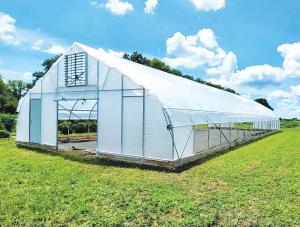2023 - Volume #47, Issue #6, Page #29
[ Sample Stories From This Issue | List of All Stories In This Issue | Print this story
| Read this issue]
Hoop Buildings Designed For Do-It-Yourselfers
 |
“It started with community breakfasts of 150 to 200 people. Food was sourced from local farms, local chefs did the cooking, and Nifty Hoops founder Jeff McCabe hosted,” says Tomm Becker, Nifty Hoops. “People would drop $10 to $15 in a jar to help fund hoop houses for local farmers.”
More than $400,000 was raised over 4 years through the one-meal per week effort. The money was loaned to local farmers, who would pick out a hoop house from a manufacturer. People from the breakfasts would volunteer to help put it up. Invariably, there would be something that didn’t work quite right or parts missing.
“We would suggest improvements to the manufacturer, but they weren’t interested,” says Becker.
In 2011, McCabe focused his attention on designing a hoop house that could be put up in a day with four or five people. Frame members are heavy-duty steel tubing, laser cut for precise cut-outs and attachment holes. This ensures simple installation, superior strength, and durability. Every package comes pre-drilled and ready to bolt together.
Based in Michigan, the emphasis is on a design that can handle the winter weather. Bows are placed every 4 ft., not the standard 5 to 6 ft. Cross braces are on every bow and oriented lower than most for more support. Gussets on every bow support the truss assembly and add strength. Steel frame end walls eliminate the need to jury-rig one.
“End walls often face head-on into the wind,” says Becker. “We often saw DIY ones built out of 2 by 4s fail. Ours come with woven reinforced plastic for even more strength.”
To handle the cold temperatures, Nifty Hoops come with a double layer of plastic and a small 12V fan that runs all the time. Becker explains that the fan does double duty.
“It inflates the two layers to help insulate, but it also keeps the plastic tight,” he explains. “Plastic wears out prematurely when it is not kept tight. The insulation means it can be 0 degrees outside and 70 to 80 inside.”
The tight plastic, combined with the long straight rafter down the peak and the Gothic design, helps the snow slide off easier. “In our northern winters, we need snow to slide off,” says Becker.
Other strength-related features include wind bracing in every corner, double aluminum quick locks with cam inserts, and roll-up curtains using the same 11-mil woven poly as with end walls.
The steel frame end walls include people access at the main door and an 8 by 8-ft. equipment access door at each end. End-wall ventilation includes 2 by 4-ft. aluminum louvers with 12V DC linear actuator motors and low-voltage thermostatic controls.
An end-to-end, 1-in. pvc conduit and fittings carry louver wiring and allow other electrical functions.
Options include automatic side ventilation with motorized roll-up, overhead irrigation, a drip irrigation kit, and trellising supplies.
Hoop houses are available in widths of 22 1/2 ft. ($5,400 to $22,000) and 30 ft. ($8,600 to $25,500). Lengths start at 24 and 40 for the two models, respectively, and run up to 192 ft.
Given that the company started with volunteers doing the installation, community builds with the company supervising the process are a popular option. Becker notes that bringing in a crew for a full installation adds thousands to the cost of a hoop house. The “erector set” nature of the design makes a community build or DIY attractive.
“Projects are usually completed in a day like an old-fashioned barn raising,” says Becker. “If a buyer wants to do the installation, we support them with manuals and videos and are available for questions. Being involved in the building process also makes it easier when the plastic over the top and end walls needs to be replaced every 8 to 10 years.”
“We have customers in Arizona and other desert states using our structures for overhead irrigation, and our double layer of plastic reduces the sunlight,” says Becker. “We have people using them with aquaponics and high-value crops like ginger and turmeric. People have put poultry in them, and others used them for wedding receptions and agritourism.”
Nifty Hoops are approved for funding through the Natural Resource and Conservation Service (NRCS). “NRCS loves us because our hoop houses actually get built,” says Becker. “Too often people order a hoop house and put off building it. The NRCS knows ours will go up and pass inspection.”
Contact: FARM SHOW Followup, Nifty Hoops, 170 Aprill Dr., Suite D, Ann Arbor, Mich. 48103 (ph 734-845-0079; info@niftyhoops.com; www.niftyhoops.com).

Click here to download page story appeared in.

Click here to read entire issue
To read the rest of this story, download this issue below or click here to register with your account number.




